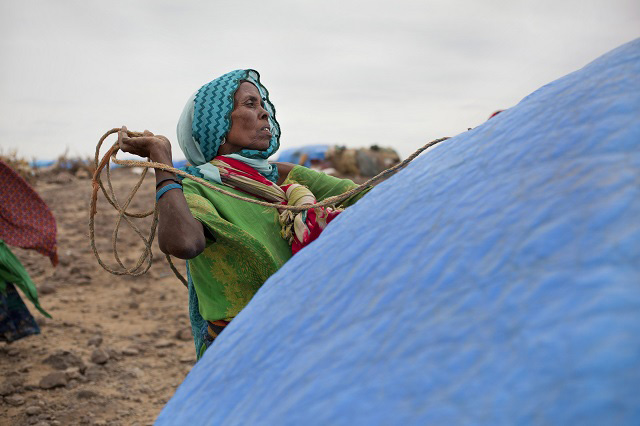
Ethiopia is currently in the grip of its worst drought in half a century. More than 10 million people — over 10 percent of the population — are affected by drought-related food insecurity. That figure has escalated from 2.9 million at the start of 2015. What “drought-related food insecurity” means in concrete terms is that three-quarters of people are living on one meal a day.
One affected person is Seido Roble, a 50-year-old grandmother living in the Harisso camp for internally displaced persons. Like many others, Roble lost wealth and a livelihood to the drought. Nationally, at least 1 million livestock have died. As Roble explained to Oxfam International:
I used to live under the mountains in Habur village — “in the bush.” We had livestock in Habur. We have been in Harisso camp for three months. We came here because we lost our livestock and we were hungry. The drought has lasted two years and it is still going. I lost 20 cattle and more than 200 goats. I lost all of them. It took 2 days to walk here. I came with my husband and my grandchildren.
As of early May, only 65 percent of the humanitarian funding need has been met, even though potential donors have known since last year of the impending catastrophe. A major portion of the $1.4 billion needed has come from the Ethiopian government, but Ethiopia is a resource-strapped country, with 30 percent of the population living on less than $1.25 a day.
Ethiopian officials have criticized the “sluggish” response of the global community, and wondered if wealthy countries’ attention has been diverted to the refugee crises in the Middle East.
Crisis reporting isn’t a zero-sum game, but sometimes it seems that way. If forced migration from the Middle East has overshadowed internal displacement in East Africa, the big drought story is coming from California rather than Ethiopia. Observers have noted an imbalance in the media coverage of the two situations. Indeed, Google — essentially the thermometer of the world’s attention span — returns 58.4 million search results for “California drought,” compared to 4.7 million for “Ethiopia drought.” This is despite the difference in the stakes (particularly the possible death toll in Ethiopia).
“We have no income. I am afraid of the weather. I am afraid of drought.”
The world’s crises can seem never-ending, especially when it comes to an emergency that seems familiar. And it’s hard to blame people for compassion fatigue. There are only so many column inches, only so much space in minds and conversations. A horrifying reality is that tragedy can become tedious.
But Ethiopia is much more than a Live Aid poster country, and the crisis situation it’s facing now differs from the one in the 1980s — the country has a more stable government and a stronger emergency management system. And El Niño has contributed to the current drought in complex ways that affect other parts of East Africa, as well as Central America.
Plus, the media aren’t necessarily concerned with reducing the tedium of repetition. For instance, the barrage of news stories about Donald Trump has been deeply dull. The formula of outrageous statement + lavish coverage has gotten more than a little monotonous. The press has also been complicit in driving voters in his direction. To put things in perspective, the $2 billion in free media attention that Trump has received exceeds the total $1.4 billion needed to address Ethiopia’s crisis.
To further contextualize these figures, Oxfam points out that, “Waiting to see if a situation becomes a large-scale crisis before committing funding and resources is a false economy.” Early action is both more effective and cheaper in the long run. Yet governments have been dragging their heels, despite urgent appeals to act before the current emergency becomes a full-blown famine.
That waiting is dangerous is very clear given that the drought-related crisis will be worst between June and September of this year. For some Ethiopians, however, it’s a paradoxical combination of drought and floods that’s making the humanitarian situation especially tough. Floods in April and May have led 120,000 people to leave their homes.
This complicates logistics. Stephanie Savariaud, a communications officer for the UN’s World Food Programme (WFP) in Ethiopia, told Truthout that, “The current floods have added a layer of complexity to the humanitarian response. Currently WFP and the [Ethiopian] government are delivering food assistance and specialized nutritious food to more than 7 million people. Some areas in the Somali region have not been accessible because of heavy rains and floods, and thousands of people have also been affected. We are looking at alternatives to reach people who have been displaced by flooding.”
It can be confusing for onlookers to grasp that Ethiopians are experiencing a double crisis of both too little water and too much. These complicated climate interactions are another aspect that makes the humanitarian situation in Ethiopia a hard sell in terms of attention.
However, according to Thomas H. Staal, acting assistant administrator for United States Agency for International Development’s Bureau for Democracy, Conflict and Humanitarian Assistance, “The ironic part is that with a slow onset disaster like a drought, we often have the opportunity to save more lives than we would with an earthquake or typhoon, which has done most of its damage by the time media coverage begins.”
This danger is also all too real to Roble, the Ethiopian grandmother collecting firewood and shoring up her family’s shelter as they wait in the camp for people displaced by drought. “I am not happy with the climate,” she said. “We have no income. I am afraid of the weather. I am afraid of drought.” For people like her, the limitations of narrative and action when it comes to global affairs have very real consequences.